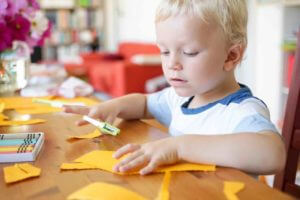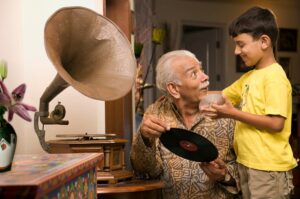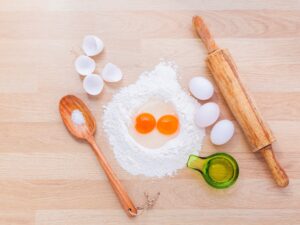Paper, paste, water, a pot and a little patience: papier-mâché is quick and easy to mix. The non-toxic paper mass can be used to make colorful sculptures and decorations, as well as everyday objects. With poster paint or acrylic paint, the works of art become colorful, clear varnish even makes them waterproof.
We teach you on how you can make papier-mâché yourself.
Table of contents
Paper Mache: Paper, Water And Paste Become Modeling Clay
Doinghandicrafts with children is no problem at all with do-it-yourself papier-mâché. The mass of paper, water and paste is quickly mixed by the children themselves. And if you don’t want to use paste, which is not entirely harmless to health, you can also make your own paste for crafting.
Curious about how to do it? Then take a look at our recipes for papier-mâché and paste to make yourself! And of course we also give you ideas for what you can do with papier-mâché and paste with children.
Crafting With Papier-mâché: What You Need
There are two types of papier-mâché: You can make a doll out of paper, paste and water and use it for crafting with children. The modeling clay will be even more stable and pleasant to work with if you stir in some sawdust.
You will find the recipe for the pulp later in the text. More common and easier are handicrafts made of old newspaper and paste. You don’t have to mix anything, you don’t need any preparation time, and the materials don’t cost anything either.
You just need some old newspapers and a packet of wallpaper paste. The latter may still be left over from the last move. If that’s not the case, you can find wallpaper paste to mix for less than two euros per packet at the hardware store.
Also interesting:- The 15 best craft kits for kids
- The 5 best bocce balls for kids
- The best craft supplies for children
Crafting With Children Strengthens Family Cohesion
Parents should do a lot of crafts with their children, because it strengthens the relationships in the family. Just like anything DIY, it has many benefits for your child’s development:
- Crafting promotes motor skills
- Do-it-yourself promotes creativity
- Crafting with children develops spatial imagination
Papier-mâché allows for great results with little material and financial input. This strengthens the children’s self-confidence and helps them to see themselves as creators. Paper mache is also great because it is relatively environmentally friendly.
If you use old newspapers and some paste, there is hardly any waste. Or, by using newspapers that have already been sorted out, you are already recycling. When doing handicrafts, children think themselves into their own worlds, can learn how to handle the materials and can completely indulge in their fantasy worlds.
Bastelst Du gemeinsam mit Deinen Kindern und sprichst mit ihnen über das, was sie basteln wollen, zeigst Du Interesse und signalisierst Deinem Kind, dass Du es mit seinen Bedürfnissen, Wünschen, Interessen und Träumen ernst nimmst. Gemeinsam schafft Ihr so tolle Projekte.

Basics: Balloon, Newspaper, Paste And An Idea
To give you a rough idea of what you can make with your child out of papier-mâché in the future, we’ll give you a few instructions. Have some paste, a balloon and a stack of old newspapers ready. Have your child blow up the balloon and tie a knot in it.
Then tear off even strips from the newspapers. the strips should be about 10 inches long and no more than 2 inches wide. Brush the balloon with paste and place the newspaper strips around the balloon. Once the entire balloon is surrounded by a single layer of newspaper, brush everything with paste again.
Then you put the second layer of paper on top. Make sure that the paper strips do not lie congruently on the previously applied strips, but overlap and close the presumably created gaps.
Once the balloon is covered all around with a second layer of paper, you need to apply another layer of paste. In total, the balloon should end up with four to eight layers of paper, depending on how stable you want the papier-mâché to be later.
Here’s What You Should Keep In Mind When Crafting
- Do not apply the paste too thickly.
- The paste must be spread evenly thin so that there are no gaps without paste.
- Put the newspaper so tightly to the balloon that there are no folds or air-filled bubbles.
- Beginning with the second paper layer at the latest, the individual paper strips must always overlap each other so that the strips join together to form a papier-mâché mass.
- When you have glued one layer of paper to the balloon, you can use the brush to brush the paper firmly against the balloon when applying the next layer of paste and remove any air bubbles and wrinkles that may be present.
After that, the balloon with its many layers of newspaper and paste should dry first. This may take a day or two, depending on how warm or cold your home is. The humidity in your rooms also plays a role, as does the type of paste you used.
You should not continue tinkering with the project until the layers of paper have hardened. When you tap the balloon with the paper, the envelope should not give. You should hear a hollow sound. The knocking will sound like when you knock on a thin wooden plate or thick, solid cardboard.
What Can You Make Out Of The Papier-mâché On The Balloon?
In the next step, you and your child decide what to make out of the balloon. Here are some suggestions:
Bicycle Basket
Cut the balloon in half, paint the two halves and seal the nicer half with a waterproof clear varnish. Use the hole punch to make two holes on one side of the shell. Thread floral wire through the holes. Use the wire to attach the new bike basket to the handlebars of the child’s bike.
Storage Bowl
Cut the balloon in half and connect the open halves with masking tape to create an open double bowl. Paint this and seal it with a clear coat.
If the bowl does not stand firmly, you can attach a stand to the bottom. To do this, cut a cardboard ring from an old toilet paper roll and attach the ring to the shell halves with masking tape. Don’t forget to paint and varnish.
Decorative Ball
Simply paint the oval shape with your child’s favorite motifs, attach a string to it and hang it up in the nursery like a Christmas ball.
Headgear For Carnival Or Role Play
Use strips of paper and paste to form animal ears, which you attach to one half of the cut open balloon. Dog, cat, bear, astronaut, cowboy, teletubbie or mouse – even an ant (antennae instead of ears) can become your child for carnival.
Make sure that the shape of the cut open balloon fits your child’s head shape. Your child should wear the headgear like a bicycle helmet. Paint the “helmet” in matching colors after the paper pulp has dried. Now all that’s missing is the rest of the costume!
Of course, there are no limits to what you can do with children. You can make cups out of the balloon as game trophies, make a salad bowl out of it for the doll’s kitchen or make a space station. You can find lots of ideas on the Internet.
Paper Mache Instead Of Clay: Modeling Clay For Little Sculptors
Crafting with children means getting a little “dirty” at times. Plasticine that really sticks to your hands, sticks to your clothes and decorates the table is very popular with children.
Paper mache is very compatible in this respect, because the paper mass can be easily removed again after crafting with the children, is non-toxic and washes out of the clothes. So papier-mâché promises a “big mess” with lots of fun and no frustration for mom – perfect, right?
You’ll need toilet paper, water, wallpaper paste and paint. Mix the ingredients in a bowl and you’re ready to go!
Mixing Papier-mâché: Crafting With Children Including Child-friendly Preparation
Have your child pluck a sufficient amount of toilet paper (preferably white or gray recycled paper with no imprint) into small shreds. Put the pieces in a bowl. Gradually pour in some water and knead the paper and water into a smooth but malleable mixture.
Keep doing this until you have enough papier mache for your craft project. You can color the mass with some acrylic paint, solid paint or (non-toxic for children) food coloring. Then add some wallpaper paste from the hardware store and knead the powder with the papier-mâché.
Now you can basically do anything with the papier-mâché that you can do with clay, Fimo, or an air-drying modeling clay. Maybe you want to make the animals for a farm craft with the kids? Or you’ll make the equipment for a store together?
Maybe you want to make a new head for a hand puppet? There are no limits to your imagination. The papier-mâché takes a long time to dry, so you can take your time. Failures in shaping the mass are not a problem. If the papier-mâché becomes too dry, simply knead in some water again. Your finished artwork will need to dry for up to three days.
Then you can paint on details (for example, the eyes of the animals or the labeling of the packaging for the store). When the paint is also dry, apply a clear coat. This protects the finished work of art and makes it durable. This makes the crafts actually suitable for playing with.
When Crafting With Children, The Material Must Be Non-toxic!
Ready-made modeling clay and modeling clay from the trade often bear the notice that they must not be put in the mouth under any circumstances and that children should wash their hands thoroughly after use. There is a reason for these warnings: the modeling clay is made of materials that can be problematic for health.
And yet the children’s room should actually be safe! It’s different with do-it-yourself papier-mâché: it’s harmless. At least it is, if you choose the individual components carefully.
The more you DIY, the more control you have over it. So here are a few more tips on how to make your papier-mâché even more natural and safe.
Make Your Own Paste: Water And Flour
You can make your own paste with water and flour. Put half a liter of water in a pot and heat the water slowly. Stir in 150 g of flour. The flour must dissolve completely in the water. The mixture will slowly become tough. Let it boil once for a short time.
If the mixture is too thick, carefully add more water. If the mass is too liquid, stir in more flour. Allow the paste to cool and then pour it into a tight-fitting container. An empty canning jar (for example, of preserved cherries or dill pickles or the like) is good. The paste will keep in the refrigerator for a good two weeks and will reliably stick all kinds of paper and cardboard.
A little more complicated is the preparation of white glue, which you can also stir into the papier-mâché from toilet paper. However, the traditional recipe is also quick and inexpensive to make. Mix one cup of flour and 1/3 cup of sugar in a saucepan.
Add half a cup of water and 1/3 cup of liquid starch. Now you should mix the mixture thoroughly. Slowly add another half to one cup of water and stir until the mixture is creamy and free of lumps.
Then stir in 1 tbsp. vinegar and heat the mixture. If it thickens, remove the pot from the heat immediately, otherwise the glue will clump. Once cooled, you can store the white glue in the refrigerator.
Non-toxic Paints For Crafting With Children
Paper mache in white is boring, when crafting with children it must be colorful. But where can you find DIY paints? You can use recipes for vegetable dyes, for example. Flower petals crushed with a little water, for example, make a delicate color that can be applied to white papier-mâché.
Non-toxic flowers include clover and dandelions, as well as roses and lavender. You can use all flowers that are edible. You can achieve stronger colors with beetroot juice (purple), blueberries (blue-violet), raspberries (pink), onion juice (yellow to brown) and spinach (green).
However, if you want to make a surface one color, you can simply apply a layer of colored paper with the paste you made yourself. Suitable are colored napkins, crepe paper (be careful, it stains!) and all kinds of colored craft papers. However, they are not always non-toxic when your child puts them in his mouth.













1 thought on “How Crafting With Papier-mâché It Works”